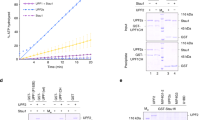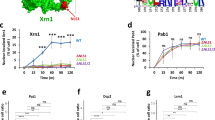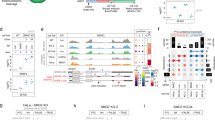Abstract
One of the main mechanisms of messenger RNA degradation in eukaryotes occurs by deadenylation-dependent decapping which leads to 5′-to-3′ decay1,2. A family of Sm-like (Lsm) proteins has been identified, members of which contain the ‘Sm’ sequence motif, form a complex with U6 small nuclear RNA and are required for pre-mRNA splicing3,4,5,6,7,8,9. Here we show that mutations in seven yeast Lsm proteins (Lsm1–Lsm7) also lead to inhibition of mRNA decapping. In addition, the Lsm1–Lsm7 proteins co-immunoprecipitate with the mRNA decapping enzyme (Dcp1), a decapping activator (Pat1/Mrt1) and with mRNA. This indicates that the Lsm proteins may promote decapping by interactions with the mRNA and the decapping machinery. In addition, the Lsm complex that functions in mRNA decay appears to be distinct from the U6-associated Lsm complex, indicating that Lsm proteins form specific complexes that affect different aspects of mRNA metabolism.
This is a preview of subscription content, access via your institution
Access options
Subscribe to this journal
Receive 51 print issues and online access
$199.00 per year
only $3.90 per issue
Buy this article
- Purchase on Springer Link
- Instant access to full article PDF
Prices may be subject to local taxes which are calculated during checkout





Similar content being viewed by others
References
Beelman, C. A. & Parker, R. Degradation of mRNA in eukaryotes. Cell 81, 179–183 (1995).
Jacobson, A. & Peltz, S. W. Interrelationships of the pathways of mRNA decay and translation in eukaryotic cells. Annu. Rev. Biochem. 65, 693–739 ( 1996).
Seraphin, B. Sm and Sm-like proteins belong to a large family: identification of proteins of the U6 as well as the U1, U2, U4 and U5 snRNPs. EMBO J. 14, 2089–2098 (1995).
Hermann, H. et al. snRNP Sm proteins share two evolutionarily conserved sequence motifs which are involved in Sm protein-protein interactions. EMBO J. 14, 2076–2088 ( 1995).
Cooper, M., Johnston, L. H. & Beggs, J. D. Identification and characterization of Uss1p (Sdb23p): a novel U6 snRNA-associated protein with significant similarity to core proteins of small nuclear ribonucleoproteins. EMBO J. 14, 2066–2075 (1995).
Salgado-Garrido, R., Bragado-Nilsson, E., Kandels-Lewis, S. & Séraphin, B. Sm and Sm-like proteins assemble in two related complexes of deep evolutionary origin. EMBO J. 18, 3451– 3462 (1999).
Mayes, A. E., Verdone, L., Legrain, P. & Beggs, J. D. Characterization of Sm-like proteins in yeast and their association with U6 snRNA. EMBO J. 18, 4321–4331 ( 1999).
Pannone, B. K., Xue, D. & Wolin, S. L. A role for the yeast La protein in U6 snRNP assembly: evidence that the La protein is a molecular chaperone for RNA polymerase III transcripts. EMBO J. 17, 7442– 7453 (1998).
Stevens, S. W. & Abelson, J. Purification of the yeast U4/U6.U5 small nuclear ribonucleoprotein particle and identification of its proteins. Proc. Natl Acad. Sci. USA 96, 7226– 7231 (1999).
Boeck, R., Lapeyre, P., Brown, C. E. & Sachs, A. B. Capped mRNA degradation intermediates accumulate in the yeast spb8-2 mutant. Mol. Cell. Biol. 18, 5062– 5072 (1998).
Decker, C. J. & Parker, R. A turnover pathway for both stable and unstable mRNAs in yeast: evidence for a requirement for deadenylation. Genes Dev. 7, 1632–1643 (1993).
Hatfield, L., Beelman, C. A., Stevens, A. & Parker, R. Mutations in trans-acting factors that inhibit mRNA decapping in Saccharomyces cerevisiae. Mol. Cell. Biol. 16, 5830 –5838 (1996).
He, W. & Parker, R. Analysis of mRNA decay pathway in S. cerevisiae. Methods 17, 3– 10 (1999).
Beelman, C. A. et al. An essential component of the decapping enzyme required for normal rates of mRNA decay in yeast. Nature 382, 642–646 (1996).
Dunckley, T. & Parker, R. The DCP2 protein is required for mRNA decapping in Saccharomyces cerevisiae and contains a functional MutT motif. EMBO J. 18, 5411– 5422 (1999).
Muhlrad, D., Decker, C. J. & Parker, R. Deadenylation of the unstable mRNA encoded by the yeast MFA2 gene leads to decapping followed by 5′ → 3′ digestion of the transcript. Genes Dev. 8, 855– 866 (1994).
Fromont-Racine, M. et al. Interactions of the Lsm proteins of S. cerevisiae Proc. Natl Acad. Sci. USA (submitted).
Wang, X., Watt, P. M., Louis, E. J., Borts, R. H. & Hickson, I. D. Pat1: a topoisomerase II-associated protein required for faithful chromosome transmission in Saccharomyces cerevisiae. Nucleic Acids Res. 24, 4791 –4797 (1996).
Kambach, C. et al. Crystal structures of two Sm protein complexes and their implications for the assembly of the spliceosomal snRNPs. Cell 96 , 375–387 (1999).
Schwartz, D. &s Parker, R. Mutations in translation initiation factors lead to increased rates of deadenylation and decapping of mRNAs in Saccharomyces cerevisiae. Mol. Cell. Biol. 19, 5247–5256 (1999).
Achsel, T. et al. A doughnut-shaped heteromer of human Sm-like proteins binds to the 3′-end of U6 snRNA, thereby facilitating U4/U6 duplex formation in vitro. EMBO J. 18, 5789– 5802 (1999).
Dix, I., Russell, C., Yehuda, S. B., Kupiec, M. & Beggs, J. D. The identification and characterization of a novel splicing protein, Isy1p, of Saccharomyces cerevisiae RNA 5, 360–368 (1999).
Tharun, S. & Parker, R. Analysis of mutations in the yeast mRNA decapping enzyme. Genetics 151, 1273 –1285 (1999).
Acknowledgements
We thank members of R.P.'s laboratory for useful discussions and comments on the manuscript. This study was supported by funds from the Howard Hughes Medical Institute, the NIH, a Wellcome Trust Prize Studentship to A.E.M. and a Royal Society Cephalosporin Fund Senior Research Fellowship to J.D.B. We also thank N. Rodriquez-Cousino for the antisera to Pat1, C. Russell for providing the HA–lsy1 strain and A. Sachs for the anti-Lsm1 antibodies.
Author information
Authors and Affiliations
Corresponding author
Rights and permissions
About this article
Cite this article
Tharun, S., He, W., Mayes, A. et al. Yeast Sm-like proteins function in mRNA decapping and decay. Nature 404, 515–518 (2000). https://doi.org/10.1038/35006676
Received:
Accepted:
Issue Date:
DOI: https://doi.org/10.1038/35006676
This article is cited by
-
The TUTase URT1 connects decapping activators and prevents the accumulation of excessively deadenylated mRNAs to avoid siRNA biogenesis
Nature Communications (2021)
-
An mRNA decapping mutant deficient in P body assembly limits mRNA stabilization in response to osmotic stress
Scientific Reports (2017)
-
The CaSm (LSm1) oncogene promotes transformation, chemoresistance and metastasis of pancreatic cancer cells
Oncogenesis (2016)
-
RIP-seq analysis of eukaryotic Sm proteins identifies three major categories of Sm-containing ribonucleoproteins
Genome Biology (2014)
-
Crystal structure and biochemical analysis of the heptameric Lsm1-7 complex
Cell Research (2014)
Comments
By submitting a comment you agree to abide by our Terms and Community Guidelines. If you find something abusive or that does not comply with our terms or guidelines please flag it as inappropriate.



